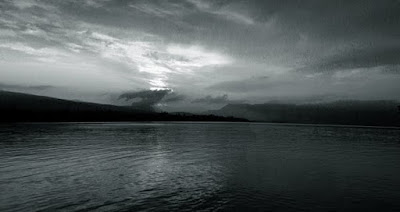I'm flying off to Phoenix, AZ tonight then driving up to Flagstaff so our group can meet with the equipment outfitter in the morning and get set up for two weeks in the Grand Canyon. We launch on December 19th with hopes that Christo will not cover it or "recontextualize" the canyon in any way, and our group can experience the canyon in it's (mostly) natural beauty and enjoy something that stands on it's own as a work of art.
The week of January 3rd will be spent in Colorado editing photos and revisiting notes from the trip.
By the 8th, I should have internet access again and will post some initial photos.
I expect this trip to provide enough source material for the entire Spring semester.
The semester starts late enough so I'll have time to collaborate with alternative photography artists in a few places around Durango and New Mexico before returning to teach.
Sunday, December 19, 2010
Saturday, December 11, 2010
On Top Of The White Whale
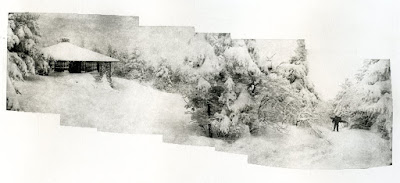
I've been working on this one since last Spring and finally have this difficult image balanced the way I like it.
The challenge has been to keep some tone in the sky and snow without just dropping the contrast.
If this was a single shot in which all elements were static I could use a modern version of an HDR image.
Since it is a panoramic, made while the figure was moving (and some wind was threatening to move the rest of the environment), I had to go old-school HDR by doing some subtle burning and dodging as well as a bit of contrast adjustment.
The Grayscale Gradient Test was an integral part of it too, since it is teaching me the limits of the KM73 polymergravure plates.
Friday, December 10, 2010
Tuesday, December 7, 2010
grayscale test for photo polymer gravure
Here is a grayscale from 100% - 0% black on top, and a grayscale from 80% - 20% black on the bottom.
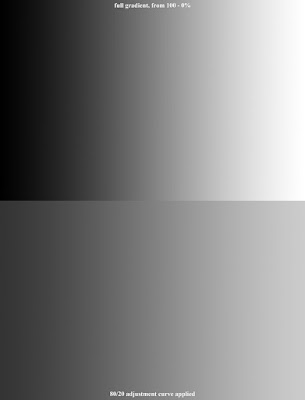
Below are two proofs from a KM73 plate using the above image on a transparency for exposure.
Each proof is wiped slightly different.
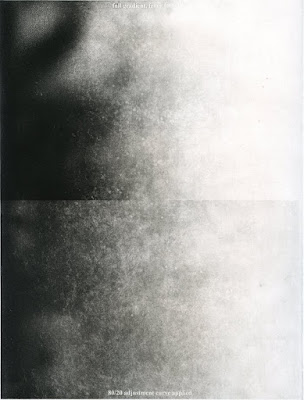
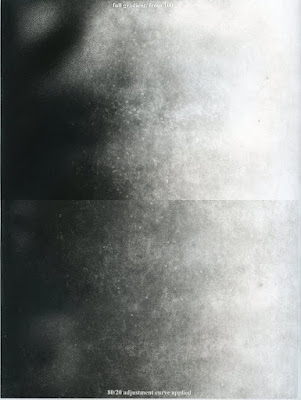
It gives me a good idea of where the values and information drop out completely, and how smooth a transition can be achieved. Using this twin scale, I have to figure out how to eliminate the white spots. There are two types. One set in which it seems that the black area washes out. I don't know if it's residual moisture left in the transparency or if there is some other gas that is not escaping. The individually scattered white dots are a bit of a mystery to me. I'll have to re-read Jon Lybrook's page on photo polymergravure again.
-----------------------------------------------------------------
The image below is a curve test for the transparency: no adjustment to the image in the top-left spot; the 80/20 adjustment I've been using in the top-right spot, and some variations in the lower two spots.
I'm still a fan of the 80/20 curve, but it looks like the 85/15 curve would be useful for adding some contrast to very flat image that would be a bit different than just adding it in Photoshop.
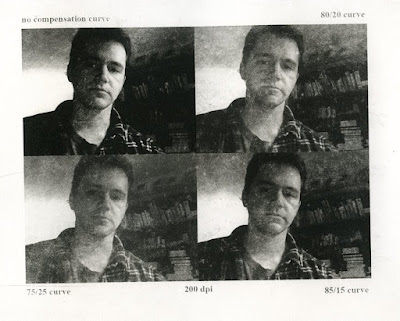
same plate. the only difference is the ink wiping strategy. It's more of a feel thing. I do this to see how I'll edition an image.
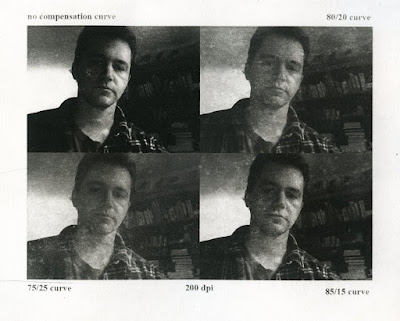
This is the file I used to make the transparency/positive for the plate above.
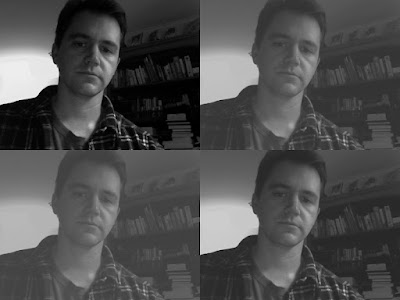
I used a simple 80/20 curve applied over the entire image to see if I could predict what the plate would do.
This is the result.
I'm surprised by the amount of information left in the top left image. That would tell me that the dropout is somewhat higher than 80% black, therefore I can pay attention to the shadows a bit more and see what details don't have to be sacrificed.
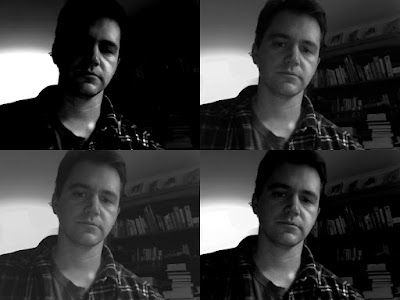

Below are two proofs from a KM73 plate using the above image on a transparency for exposure.
Each proof is wiped slightly different.


It gives me a good idea of where the values and information drop out completely, and how smooth a transition can be achieved. Using this twin scale, I have to figure out how to eliminate the white spots. There are two types. One set in which it seems that the black area washes out. I don't know if it's residual moisture left in the transparency or if there is some other gas that is not escaping. The individually scattered white dots are a bit of a mystery to me. I'll have to re-read Jon Lybrook's page on photo polymergravure again.
-----------------------------------------------------------------
The image below is a curve test for the transparency: no adjustment to the image in the top-left spot; the 80/20 adjustment I've been using in the top-right spot, and some variations in the lower two spots.
I'm still a fan of the 80/20 curve, but it looks like the 85/15 curve would be useful for adding some contrast to very flat image that would be a bit different than just adding it in Photoshop.

same plate. the only difference is the ink wiping strategy. It's more of a feel thing. I do this to see how I'll edition an image.

This is the file I used to make the transparency/positive for the plate above.

I used a simple 80/20 curve applied over the entire image to see if I could predict what the plate would do.
This is the result.
I'm surprised by the amount of information left in the top left image. That would tell me that the dropout is somewhat higher than 80% black, therefore I can pay attention to the shadows a bit more and see what details don't have to be sacrificed.

Thursday, December 2, 2010
Friday, November 26, 2010
campfire
(version 1)
vine black ink, white paper
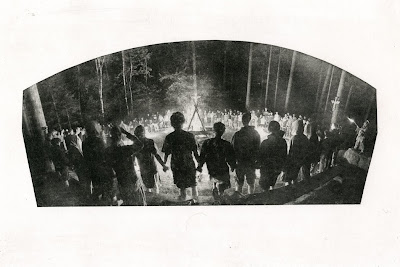
I experimented with the contact between the positive/transparency and the plate for this one, seeing if I could get either a distressed or aged look. The result is good, but I'm wondering if I took it a bit too far. I'll make another version in cleaner conditions, and with better contact to see if a more clear image still holds up and gives the desired effect.
I'm looking to elicit the feeling of an old tradition by taking an image of a gathering from this past year and developing it with an older process of printing. Experimenting with some warmer black ink and some dark browns (perhaps even a some kind of sepia tone), and an off-white print paper might help signify age and tradition.
(version 2)
dark brown ink, white paper
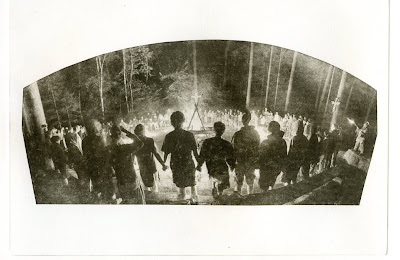
(version 3)
dark brown ink, off white paper
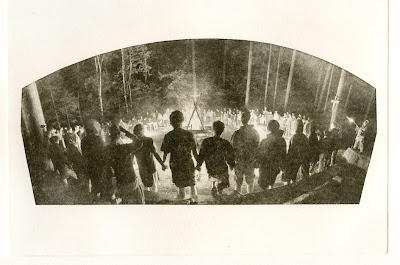
(version 4)
new plate, vine black ink, white paper
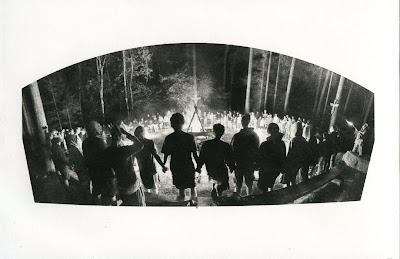
vine black ink, white paper

I experimented with the contact between the positive/transparency and the plate for this one, seeing if I could get either a distressed or aged look. The result is good, but I'm wondering if I took it a bit too far. I'll make another version in cleaner conditions, and with better contact to see if a more clear image still holds up and gives the desired effect.
I'm looking to elicit the feeling of an old tradition by taking an image of a gathering from this past year and developing it with an older process of printing. Experimenting with some warmer black ink and some dark browns (perhaps even a some kind of sepia tone), and an off-white print paper might help signify age and tradition.
(version 2)
dark brown ink, white paper

(version 3)
dark brown ink, off white paper

(version 4)
new plate, vine black ink, white paper

Labels:
alternative,
aquatint,
etching,
gravure,
photography,
polymer
Thursday, November 25, 2010
Alternative Photography
Has made a web page for me to showcase my completed images, using the polymer photo gravure process.
http://www.alternativephotography.com/gallery/v/scott-barnes/
I am very happy that my work has developed enough to be accepted into this community, and am flattered that they have made a page for me.
Here is a descriptive quote from the header on the alternativephotography.com website:
"Historical photographic methods in use today - the art, processes and techniques of alternative photography"
There are too many unique techniques to list on this blog. Please enjoy my work, but you are also encouraged to explore the Alternative Photography website and look at the engaging work by other artists using varied historical photographic techniques.
http://www.alternativephotography.com/gallery/v/scott-barnes/
I am very happy that my work has developed enough to be accepted into this community, and am flattered that they have made a page for me.
Here is a descriptive quote from the header on the alternativephotography.com website:
"Historical photographic methods in use today - the art, processes and techniques of alternative photography"
There are too many unique techniques to list on this blog. Please enjoy my work, but you are also encouraged to explore the Alternative Photography website and look at the engaging work by other artists using varied historical photographic techniques.
Monday, November 22, 2010
There is the ordinary, banal, too often falsely raised in the art world..blah blah blah .... but isn't it more special when you recognize those feelings that are the heightened moments of arousal, or maybe just awareness, the moment of special connections, something you can almost put your finger on........ those feelings....... as you recognize them...... that exceptional experience......
what does that LOOK like?
I wonder...
Translating feelings, impressions, into a visual language challenges me to look deep inside, filter out the rest, while focusing on the real connection to that heightened state, in a way that discovers the sensation that makes it so good that it keep playing over and over again in your mind.
what does that LOOK like?
I wonder...
Translating feelings, impressions, into a visual language challenges me to look deep inside, filter out the rest, while focusing on the real connection to that heightened state, in a way that discovers the sensation that makes it so good that it keep playing over and over again in your mind.
Sunday, November 21, 2010
Keep Paddling (the river keeps moving)
working through frustration, to emerge on the other side...
The photopolymer graveur process has become frustrating. I don't know whether I've become more demanding, with a more finely tuned eye for detail, or I'm just hitting some sort of sophomore jinx with a new process. Perhaps some things are not working right this week. I'm encouraged by some of things I've learned while making mistakes, but frustrated that the final result is not right. The photopolymer graveur process is still new to me, but screen printing is not. I've made three attempts at one image with a screen today, with poor results.
I have three options.
1. Should I give up completely?
2. Should I take a long break and come back to the problems later?
3. Should I keep pushing forward, finding a way to turn anger and frustration into determintation?
I am a fan of option #3. It is one that I naturally follow, and a belief that my experience on whitewater (and other outdoor activities) has reinforced. The river will not stop moving. I will make mistakes along the way, but I need to forget them immediately after they happen and keep moving forward.
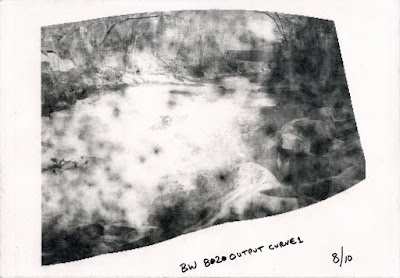
I'm inspired by some of the students in my studio classes. Their frustrated learning curve is palpable, particularly when I hear them let out a big sigh, drop their shoulders, and look away from their drawing. What has encouraged me so much, lately, is the frequency with which the return to their work, trusting the process of looking/drawing/looking/drawing/etc. Their faith in the process, and belief that they will make progress, moves me forward in my own work, and give me faith that I, too, will make progress.
Beginners mind...
_______________________________________________________________________
update (Oct. 15)
made some progress with the photo gravure
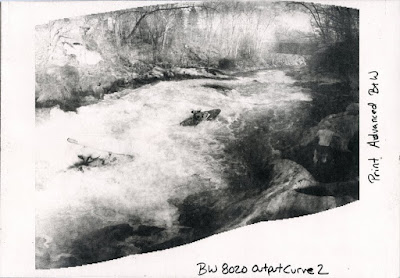
solved the contact problem, mostly...
I admit that I was not as clean as I should have been, so the three pieces of dust tented the transparency enough to lighten up the right side, BUT everything else is looking pretty good, so at least the work flow is good now.
downside is that I still can't make a screen for anything....
I've done so many of these that I can't figure out what I am doing wrong.
It will wait for the weekend. I need a break for now.
_________________________________________________________________________
update #3:
I have not liked the overall image, and did not trust how much information would be lost with the gravure process, so I decided to do alot of burning and dodging in photoshop. This was all done while clicking the preview filter on and off to predict results.
After a while I decided, since nothing was working perfectly and this was becoming an experimental piece anyway, to push the burn and dodge to extremes, betting on anything above 80% and below 20% blowing out to pure black or white.
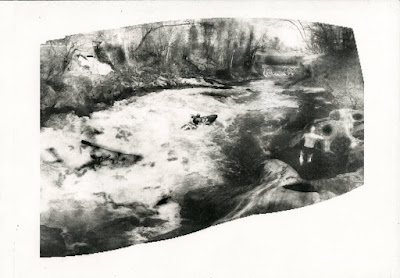
My guesses were about half correct. I pushed it a bit too far, and the image is awkward. But, the extreme example is a good way to learn, and I will keep this one for future reference.
________________________________________________________________________
update #4:
This is a good image. Adjustments in Photoshop improved the image. I am learning how the preview curve actually relates to the final product. The transparency/positive was good. The only problem with this plate was a lack of good contact in the lower right corner. I'll clean the glass on the exposure unit and the print frame before plate #5.
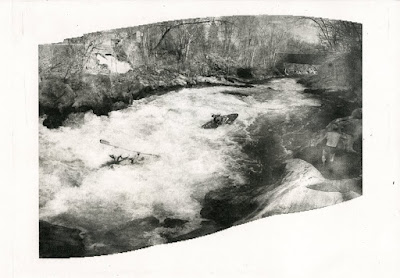
_________________________________________________________________________
update #5:
This is the final image.
Contact with the frame was good.
I dried the transparency with a hair dryer to make sure it did not contain any moisture.
I had taken the advice of a friend and sprayed the back of my positive/transparency with matte medium to eliminate Newton's Rings. The same person discovered why baby powder was useful in this process. Brush it on the plate, then brush it off. The super thin residual film of talc will create just enough space for gas and water vapor to escape during exposure. Talc is fine enough to not act like dust and create exposure issues. I imagine that using baby powder would make my results even more predictable.
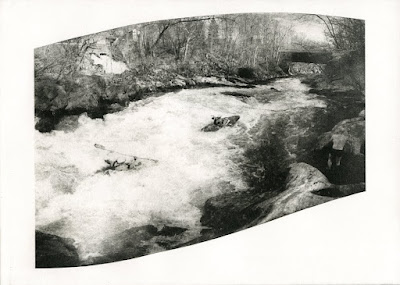
I will edition this plate.
The next step is to figure out which tone paper, and what color ink I will use for the edition.
_________________________________________________________________________
Here are the plates in order, for easier comparison.





http://artandwater.blogspot.com/2010/06/photopolymer-graveur-curves-preview-in.html
http://artandwater.blogspot.com/2010/04/solarplate-etching.html
http://artandwater.blogspot.com/2010/04/photo-polymer-gravure.html
http://artandwater.blogspot.com/2010/05/plate-decisions-and-editioning.html
http://artandwater.blogspot.com/2010/05/photopolymer-aquatint-grayscale-test.html
http://artandwater.blogspot.com/2010/05/variety-in-three-editions.html
http://artandwater.blogspot.com/2010/05/better-look.html
The photopolymer graveur process has become frustrating. I don't know whether I've become more demanding, with a more finely tuned eye for detail, or I'm just hitting some sort of sophomore jinx with a new process. Perhaps some things are not working right this week. I'm encouraged by some of things I've learned while making mistakes, but frustrated that the final result is not right. The photopolymer graveur process is still new to me, but screen printing is not. I've made three attempts at one image with a screen today, with poor results.
I have three options.
1. Should I give up completely?
2. Should I take a long break and come back to the problems later?
3. Should I keep pushing forward, finding a way to turn anger and frustration into determintation?
I am a fan of option #3. It is one that I naturally follow, and a belief that my experience on whitewater (and other outdoor activities) has reinforced. The river will not stop moving. I will make mistakes along the way, but I need to forget them immediately after they happen and keep moving forward.

I'm inspired by some of the students in my studio classes. Their frustrated learning curve is palpable, particularly when I hear them let out a big sigh, drop their shoulders, and look away from their drawing. What has encouraged me so much, lately, is the frequency with which the return to their work, trusting the process of looking/drawing/looking/drawing/etc. Their faith in the process, and belief that they will make progress, moves me forward in my own work, and give me faith that I, too, will make progress.
Beginners mind...
_______________________________________________________________________
update (Oct. 15)
made some progress with the photo gravure

solved the contact problem, mostly...
I admit that I was not as clean as I should have been, so the three pieces of dust tented the transparency enough to lighten up the right side, BUT everything else is looking pretty good, so at least the work flow is good now.
downside is that I still can't make a screen for anything....
I've done so many of these that I can't figure out what I am doing wrong.
It will wait for the weekend. I need a break for now.
_________________________________________________________________________
update #3:
I have not liked the overall image, and did not trust how much information would be lost with the gravure process, so I decided to do alot of burning and dodging in photoshop. This was all done while clicking the preview filter on and off to predict results.
After a while I decided, since nothing was working perfectly and this was becoming an experimental piece anyway, to push the burn and dodge to extremes, betting on anything above 80% and below 20% blowing out to pure black or white.

My guesses were about half correct. I pushed it a bit too far, and the image is awkward. But, the extreme example is a good way to learn, and I will keep this one for future reference.
________________________________________________________________________
update #4:
This is a good image. Adjustments in Photoshop improved the image. I am learning how the preview curve actually relates to the final product. The transparency/positive was good. The only problem with this plate was a lack of good contact in the lower right corner. I'll clean the glass on the exposure unit and the print frame before plate #5.

_________________________________________________________________________
update #5:
This is the final image.
Contact with the frame was good.
I dried the transparency with a hair dryer to make sure it did not contain any moisture.
I had taken the advice of a friend and sprayed the back of my positive/transparency with matte medium to eliminate Newton's Rings. The same person discovered why baby powder was useful in this process. Brush it on the plate, then brush it off. The super thin residual film of talc will create just enough space for gas and water vapor to escape during exposure. Talc is fine enough to not act like dust and create exposure issues. I imagine that using baby powder would make my results even more predictable.

I will edition this plate.
The next step is to figure out which tone paper, and what color ink I will use for the edition.
_________________________________________________________________________
Here are the plates in order, for easier comparison.





http://artandwater.blogspot.com/2010/06/photopolymer-graveur-curves-preview-in.html
http://artandwater.blogspot.com/2010/04/solarplate-etching.html
http://artandwater.blogspot.com/2010/04/photo-polymer-gravure.html
http://artandwater.blogspot.com/2010/05/plate-decisions-and-editioning.html
http://artandwater.blogspot.com/2010/05/photopolymer-aquatint-grayscale-test.html
http://artandwater.blogspot.com/2010/05/variety-in-three-editions.html
http://artandwater.blogspot.com/2010/05/better-look.html
Labels:
aquatint,
etching,
graveur,
gravure,
photopolymer,
solarplate
Saturday, November 20, 2010
Life Drawing instruction blog
I just started this new blog for the sake of art students enrolled in my Life Drawing class at Fairleigh Dickinson University. It acts as a supplement to the class work. Feel free to comment on it. I am particularly interested in the comments from current students as well as fellow artists.
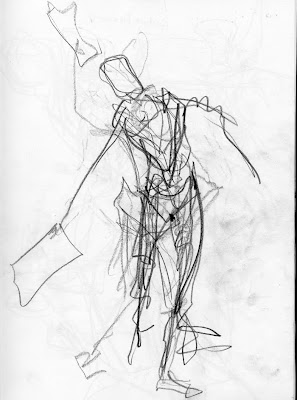
This is an example of two 30 second gesture drawings done on top of each other.
The challenge is to keep proportion in mind, but work fast, without pausing to measure. It is an excersize to loosen up your hand and eye in the beginning of class. It will also train you to see the bigger picture and not be distracted by details of a figure (which can be added in much later if you wish).

This is an example of two 30 second gesture drawings done on top of each other.
The challenge is to keep proportion in mind, but work fast, without pausing to measure. It is an excersize to loosen up your hand and eye in the beginning of class. It will also train you to see the bigger picture and not be distracted by details of a figure (which can be added in much later if you wish).
Friday, November 19, 2010
General Drawing instruction blog
I just started this new blog for the sake of art students enrolled in my General Drawing class at Fairleigh Dickinson University. It acts as a supplement to the class work. Feel free to comment on it. I am particularly interested in the comments from current students as well as fellow artists.
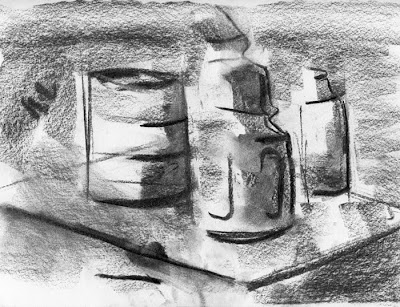
This 60 second drawing is an example of how you want to address the entire page at the start.
You can use a light touch to feel your way around the page and dictate how you want to crop what you see in front of you, turning into a picture on a page.
Quickly define where the shadows will be. You can fine tune later with an eraser and a pencil/charcoal to make the light areas lighter (eraser) and the dark areas darker (pencil/charcoal).

This 60 second drawing is an example of how you want to address the entire page at the start.
You can use a light touch to feel your way around the page and dictate how you want to crop what you see in front of you, turning into a picture on a page.
Quickly define where the shadows will be. You can fine tune later with an eraser and a pencil/charcoal to make the light areas lighter (eraser) and the dark areas darker (pencil/charcoal).
Exposure choices and adjustments for Gravure printing (photo sensitive polymer)
Monday, November 15, 2010
N.Y. Feminist Art Institute workshop at FDU
will take place during my General Drawing class on Tuesday, November 16th, 5:30 - 8:00
http://www.nyfai.org/visualdiaries/index.html
http://www.nyfai.org/currentactivities.html
from the flyer/prospectus:
"Consciousness-Raising, Visual Diaries, Art-Making Workshop.
The visual expression of wordless feelings; personal heiroglyphics linked with content through consciousness raising."
This should prove to be very exciting and elightening. I hope that it helps give students courage to create and express beyond the (sometimes) narrow confines of academia, and give them another set of tools through which they can find their own voice.
http://www.nyfai.org/visualdiaries/index.html
http://www.nyfai.org/currentactivities.html
from the flyer/prospectus:
"Consciousness-Raising, Visual Diaries, Art-Making Workshop.
The visual expression of wordless feelings; personal heiroglyphics linked with content through consciousness raising."
This should prove to be very exciting and elightening. I hope that it helps give students courage to create and express beyond the (sometimes) narrow confines of academia, and give them another set of tools through which they can find their own voice.
Friday, November 12, 2010
Prints in San Francisco this weekend
Saturday, July 17, 2010
Monhegan Watercolors
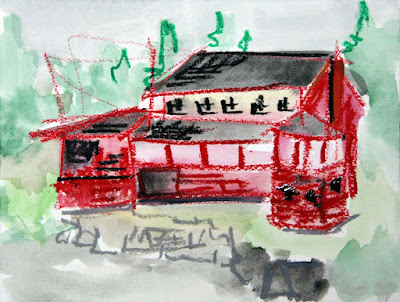
I decided to change things up a bit this year for the Camp Kawanhee group out on the island by adding a more playful technique (hoping to keep the interest of some very active kids as they wait for their turn to go fishing with Captain Chris Cash.

Combining watercolor and oil pastel created interesting effects, and gave the kids confidence to just draw what they saw in front of them.
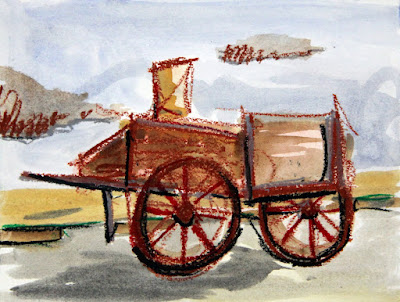
These 4 images are my 5 min demos, made at the beginning of each 2 hour session.

The campers' work can be found by surfing over to the camp's weekly newsletter website http://www.kawanhee.com/wigwam/ewigwam_issue_04.pdf
Wednesday, June 9, 2010
adjustment curves as preview for Photopolymer Graveur
this is just the beginning (because I am just beginning)...
below is the original digital image collage, converted to grayscale, but otherwise untouched/unadjusted
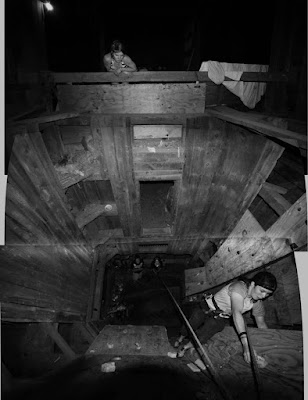
photopolymer graveur (aquatint, "safe" etching, whatever you call it) will drop out values above 80% and below 20%. In other words at those points the value will go right to black or white. So, the grayscale really only runs between the two, in the middle ground, and is not subtle at all towards the end of the scale. (I have been told this is mostly true for the original Photo Graveur, and had to be addressed. Difference in this process is that most of the adjustment is on the computer and not the development process)
I have seen a couple of curves claiming to solve this issue, but they (in my opinion) only work at the cost of some variety in the middle of the scale. I suspect this is because they are trying to bring up values that are not there.
The best thing I have discovered (to date) is the simple idea of getting a reliable preview. No matter how much you adjust your image, it is difficult to guess how much information will be lost. So, when you think you are ready to go, I'd suggest adding on more adjustment layer, and moving the sliders over from 0 to 20, and from 100 to 80. Check out the results...
below is the adjusted image: it is the first (above) image, with the curves adjusted at 20 and 80 as a way for me to preview my results from the polymer plate.
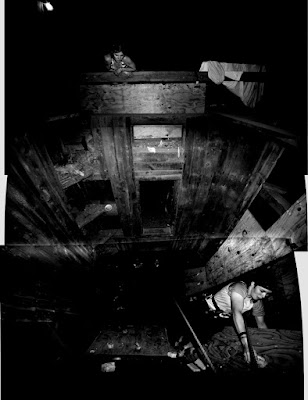
below is the actual printed image from a KM73 photopolymer plate.
There is a bit of information loss in the scan, but this is a pretty representation of what it looks like.
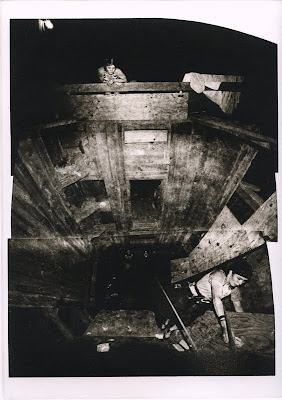
To clarify:
Top image is the original, and the one I printed on a high quality transparency (Pictorico), and used to expose the KM73 photopolymer plate.
Middle image is the top image, with an adjustment layer (Curves) over it, sliders moved from 0 to 20 and from 100 to 80 to get a preview of how the image will look from the KM73 plate, knowing that information is lost above 80 and below 20. It is only a way to get a sort of soft proof, to make sure I am on the right track.
No matter how I adjust the image before printing to the transparency, I want to do this preview before printing to see if it will be satisfactory.
BE SURE TO UNDO THIS STEP BEFORE YOU PRINT!!! It is a preview technique only.
Bottom image is printed from the KM73 polymergraveur plate onto Rives BFK white paper with Graphic Chemical Vine Black etching ink.
For those who have yet to discover this process (or have only just heard of it), here is a nice overview by someone else
http://www.alternativephotography.com/wp/processes/photogravure/photo-polymer-gravure-the-whys
below is the original digital image collage, converted to grayscale, but otherwise untouched/unadjusted

photopolymer graveur (aquatint, "safe" etching, whatever you call it) will drop out values above 80% and below 20%. In other words at those points the value will go right to black or white. So, the grayscale really only runs between the two, in the middle ground, and is not subtle at all towards the end of the scale. (I have been told this is mostly true for the original Photo Graveur, and had to be addressed. Difference in this process is that most of the adjustment is on the computer and not the development process)
I have seen a couple of curves claiming to solve this issue, but they (in my opinion) only work at the cost of some variety in the middle of the scale. I suspect this is because they are trying to bring up values that are not there.
The best thing I have discovered (to date) is the simple idea of getting a reliable preview. No matter how much you adjust your image, it is difficult to guess how much information will be lost. So, when you think you are ready to go, I'd suggest adding on more adjustment layer, and moving the sliders over from 0 to 20, and from 100 to 80. Check out the results...
below is the adjusted image: it is the first (above) image, with the curves adjusted at 20 and 80 as a way for me to preview my results from the polymer plate.

below is the actual printed image from a KM73 photopolymer plate.
There is a bit of information loss in the scan, but this is a pretty representation of what it looks like.

To clarify:
Top image is the original, and the one I printed on a high quality transparency (Pictorico), and used to expose the KM73 photopolymer plate.
Middle image is the top image, with an adjustment layer (Curves) over it, sliders moved from 0 to 20 and from 100 to 80 to get a preview of how the image will look from the KM73 plate, knowing that information is lost above 80 and below 20. It is only a way to get a sort of soft proof, to make sure I am on the right track.
No matter how I adjust the image before printing to the transparency, I want to do this preview before printing to see if it will be satisfactory.
BE SURE TO UNDO THIS STEP BEFORE YOU PRINT!!! It is a preview technique only.
Bottom image is printed from the KM73 polymergraveur plate onto Rives BFK white paper with Graphic Chemical Vine Black etching ink.
For those who have yet to discover this process (or have only just heard of it), here is a nice overview by someone else
http://www.alternativephotography.com/wp/processes/photogravure/photo-polymer-gravure-the-whys
Tuesday, May 18, 2010
edition variations
since this is pretty new and experimental (at least to me) I've been starting small editions from one plate then having to move on to other things, leaving the paper to rebound. Therefore, when resoaked, it stretches differently and makes registration of the next plate next to impossible.
I did a run of about 12, matching the same sized second plate as best as possible. (image on right)
Next, I cut down that second plate, changed the ink color and ran an edition of 10. (image in center)
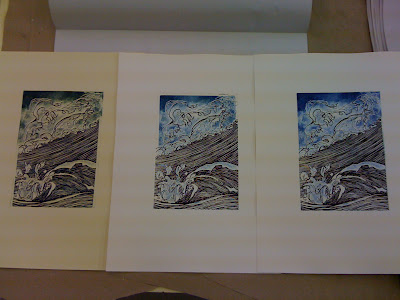
I liked the play with overlap and small shift in scale, so decided to cut the plate on the next run with a bigger edition of 20. (image on left)
A note about this last image... the line drawing plate was the one that was cut down and printed second; the opposite of the other two images. The larger "background" color does recede because of the design, but the scale of the two plates makes it appear to advance a bit. I enjoy the slight confusion between scale and overlap.
There is one more plate that will get involved with this series.
I think I may leave one of the editions as it is now, but the other two will get at least one more color.
and just a fun photo showing plates in post exposure to make sure they are fully cured...

I did a run of about 12, matching the same sized second plate as best as possible. (image on right)
Next, I cut down that second plate, changed the ink color and ran an edition of 10. (image in center)

I liked the play with overlap and small shift in scale, so decided to cut the plate on the next run with a bigger edition of 20. (image on left)
A note about this last image... the line drawing plate was the one that was cut down and printed second; the opposite of the other two images. The larger "background" color does recede because of the design, but the scale of the two plates makes it appear to advance a bit. I enjoy the slight confusion between scale and overlap.
There is one more plate that will get involved with this series.
I think I may leave one of the editions as it is now, but the other two will get at least one more color.
and just a fun photo showing plates in post exposure to make sure they are fully cured...

Aquatint Test on Polymer Photo Intaglio plates
Wanting to see the difference between thin plates (from Takach Press the KM Photopolymer plate is .017" thick) and medium thickness plates (from Boxcar Press the KM 73 Photopolymer plate is .030" thick ), thinking that the thicker plates might have a more forgiving and fuller grayscale range.
Also wanted to see how much darker a shorter exposure would be.
Here are all the images in order of printing. (number and info is below each image)

image #3 from KM photopolymer plate from Takach Press
10' stocastic screen aquatint exposure and 10' image exposure

image #5 from KM photopolymer plate from Takach Press
10' stocastic screen aquatint exposure and 8' image exposure

image #7 from KM photopolymer plate from Takach Press
10' stocastic screen aquatint exposure and 6' image exposure

image #9 from KM73 photopolymer plate from Boxcar Press
10' stocastic screen aquatint exposure and 10' image exposure

image #11 from KM73 photopolymer plate from Boxcar Press
10' stocastic screen aquatint exposure and 8' image exposure

image #13 from KM73 photopolymer plate from Boxcar Press
10' stocastic screen aquatint exposure and 6' image exposure

image #15 from KM73 photopolymer plate from Boxcar Press
10' stocastic screen aquatint exposure and 5' image exposure
Also wanted to see how much darker a shorter exposure would be.
Here are all the images in order of printing. (number and info is below each image)

image #3 from KM photopolymer plate from Takach Press
10' stocastic screen aquatint exposure and 10' image exposure

image #5 from KM photopolymer plate from Takach Press
10' stocastic screen aquatint exposure and 8' image exposure

image #7 from KM photopolymer plate from Takach Press
10' stocastic screen aquatint exposure and 6' image exposure

image #9 from KM73 photopolymer plate from Boxcar Press
10' stocastic screen aquatint exposure and 10' image exposure

image #11 from KM73 photopolymer plate from Boxcar Press
10' stocastic screen aquatint exposure and 8' image exposure

image #13 from KM73 photopolymer plate from Boxcar Press
10' stocastic screen aquatint exposure and 6' image exposure

image #15 from KM73 photopolymer plate from Boxcar Press
10' stocastic screen aquatint exposure and 5' image exposure
Friday, May 7, 2010
photopolymer graveur test and aquatint editioning
digital printout of the composite photo on top
and two choices (two different plates) to help see how it actually prints

These 24 prints are the first pass / first color of an edition.
The edition will most likely be 20 or 21, keeping in mind that it will take two or three experiments to get the second color correct.

and two choices (two different plates) to help see how it actually prints

These 24 prints are the first pass / first color of an edition.
The edition will most likely be 20 or 21, keeping in mind that it will take two or three experiments to get the second color correct.

Subscribe to:
Comments (Atom)




